Campanula bellflower flower is an elegant and very beautiful plant, which is perfect for decorating an apartment, balcony or terrace. An abundantly flowering culture caresses the eye with hundreds of miniature flowers of bright colors.
Material Content:
Origin, types and varieties of Campanula
A herbaceous plant, considered to be a native of the Mediterranean, is characterized by a very wide habitat in regions with a temperate climate. It can be found in flat areas, mountain slopes and in mixed forests. The distinctive shape of the flower in the form of a regular bell served the emergence of the Latin name campanula, which literally translates as "bell". Cultural shoots, as a rule, hanging due to the severity of simple or racemose inflorescences. In the wild, the genus unites about 400 species, of which only a few are used in indoor floriculture, including cultivars.
Campanula Equivalent
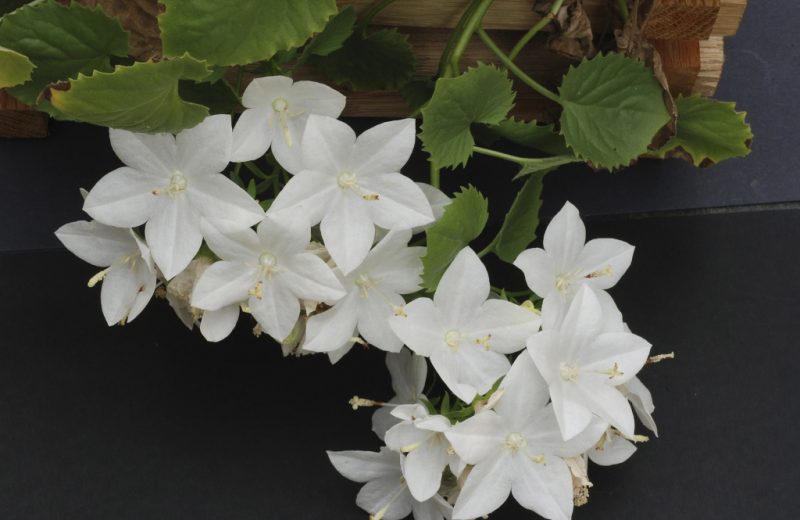
A short flower up to 30 cm in height with hanging shoots covered with carved petiole leaf blades of bright green color, often due to the peculiarity of the structure of the stems it is used in hanging pots.Since two varieties with blue and white numerous flowers are usually planted in one container, the people often call it “Bride and Groom”.
Campanula Blauranca

Derived from Campanula Pozharsky, distinguished by large leaves and inflorescences that develop on low shoots not exceeding a height of 20 cm.When flowering, the variety captivates with sky-blue flowers that will look harmoniously both in the apartment interior and in the design of the garden.
Terry Campanula
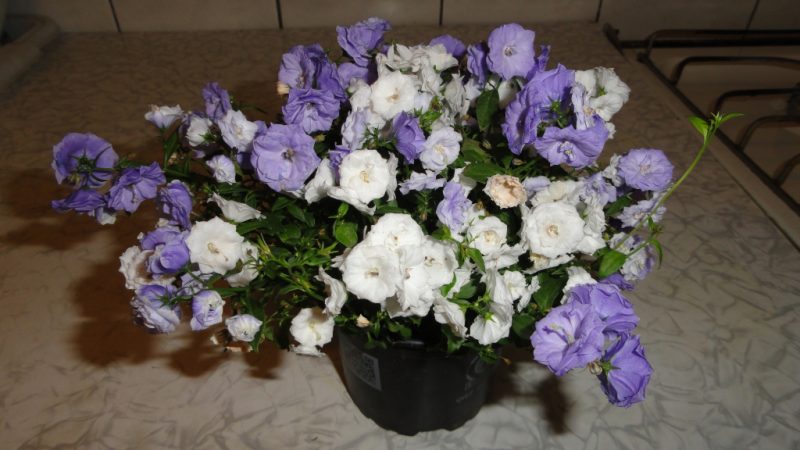
The result of the work of breeders who crossed the Carpathian and Campanulian Campanula, received such an unusual hybrid with terry inflorescences of various colors. Thin and graceful shoots drown in the dense foliage and are barely noticeable. But despite such marvelous beauty, not every grower seeks to acquire this kind of bell because of the capriciousness of his character and exactingness to certain conditions of detention.
Campanula Carpathian
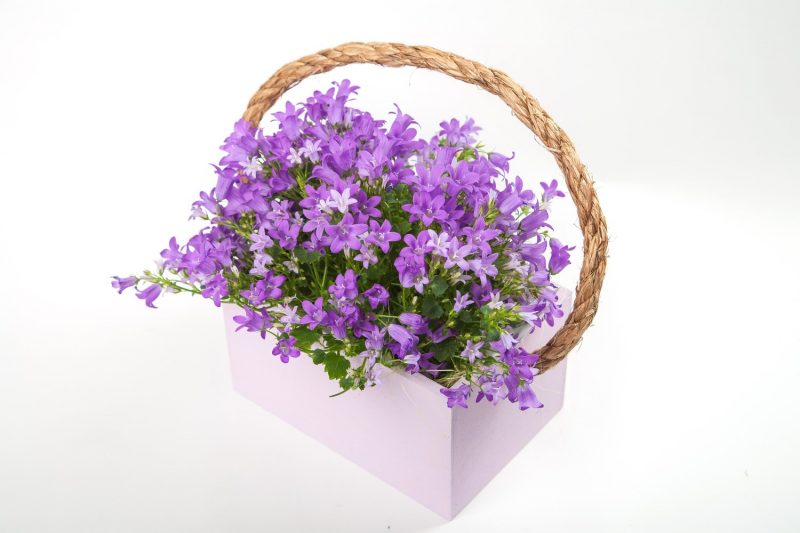
Plants with basal leaf rosettes and white, blue or purple flowers with a diameter of up to 5 cm. Famous varieties: white "Alba", pale blue "Isabelle" and "Carpatencrone" with purple inflorescences.
Basic growing requirements
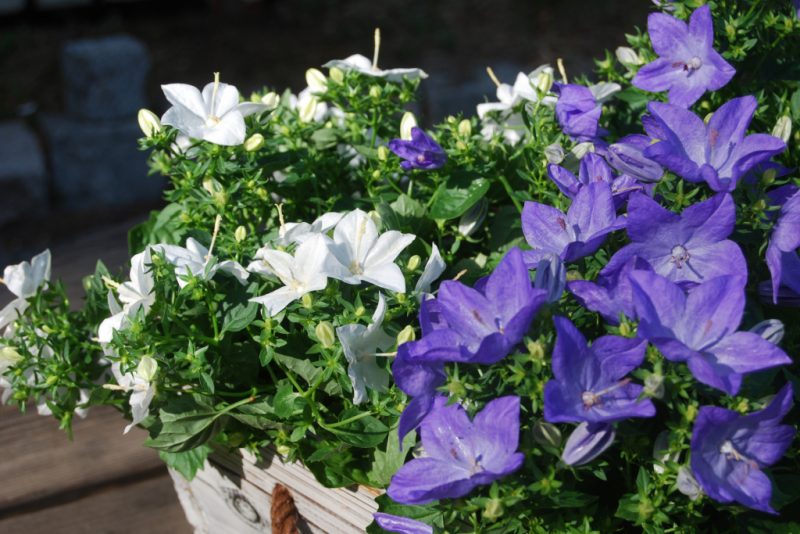
When growing a campanula, it is necessary to take into account a number of requirements dictated by the botanical characteristics of the flower and the natural growing conditions:
- providing an abundance of scattered light;
- organization of regular watering;
- establishing a suitable temperature regime, depending on the season.
Campanula bellflower home flower: planting and transplanting
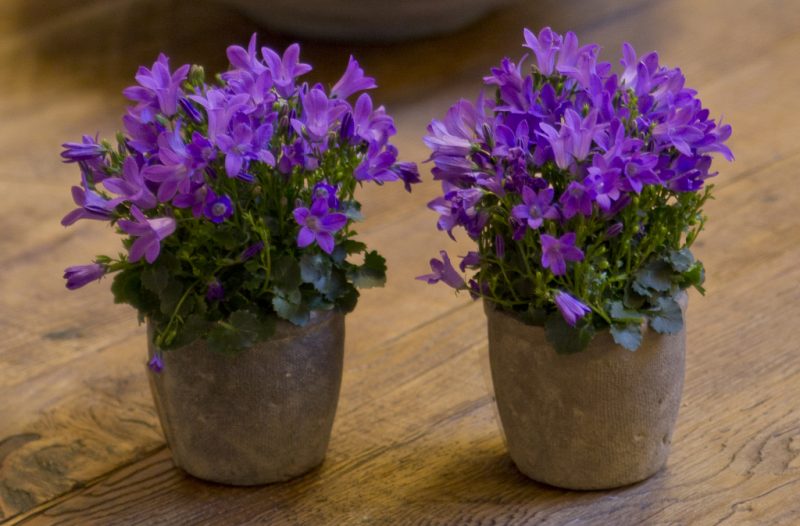
Indoor flower can be grown from seeds, for this:
- A shallow container is prepared and filled with a loose substrate of turf, sheet soil and sand in equal parts.
- Seeds are distributed on the surface and slightly crushed by sand.
- Crops are moistened from a spray bottle and covered with a film.
- When shoots appear, the film is removed.
- After the formation of three true leaves, seedlings dive into individual pots.
As the root system of the bell develops rapidly, next spring the plant is transplanted into new, capacious containers that are filled with a nutrient substrate.
Attention! The life cycle of the campanula is 2 to 3 years, so at this time it is advisable to replace the transplant with vegetative propagation.
Seasonal conditions for the plant
In order for lush bushes to please the grower with their bright greenery and plentiful flowering, it is necessary to provide the bell with certain conditions of detention.
Lighting
When placing a flower, preference should be given to eastern and western windows.
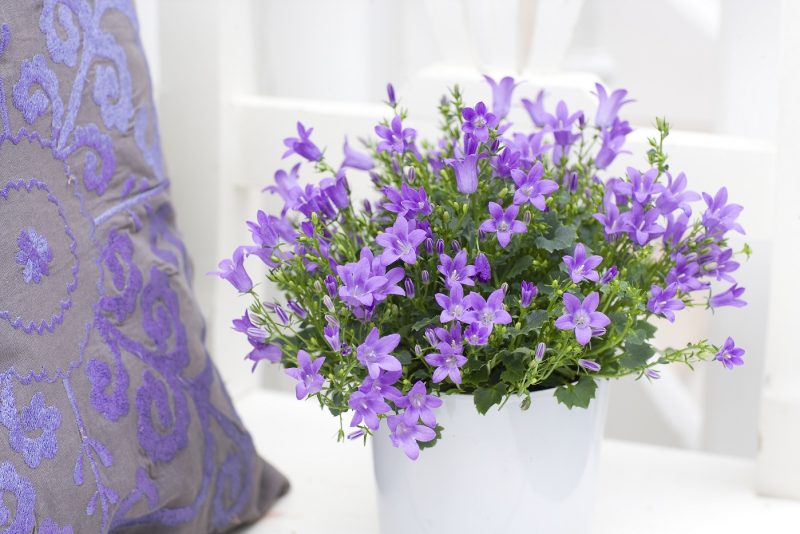
If you install the plant on the northern windowsill, where it will experience a lack of lighting, the shoots of the campanula can stretch out and lose decorativeness.
Temperature
The temperature regime depends on the season and the phase of development of the plant:
- In the spring-summer period with intensive growth, the bell is provided with temperatures in the range from 20 to 24 ° C.
- With the arrival of autumn colds, the campanula is cut and moved to a cool place with temperature values of 12-14 ° C.
Advice! In the summer heat, so that the plant tolerates it easier, it is recommended to move the pot to fresh air with protection from direct sunlight.
Humidity
The flower needs spraying only in extreme heat in the summer or in the winter when placing the pot near heating appliances.
Home Care
It is very simple to take care of the bell under the created optimal conditions of detention.
Features of watering and top dressing
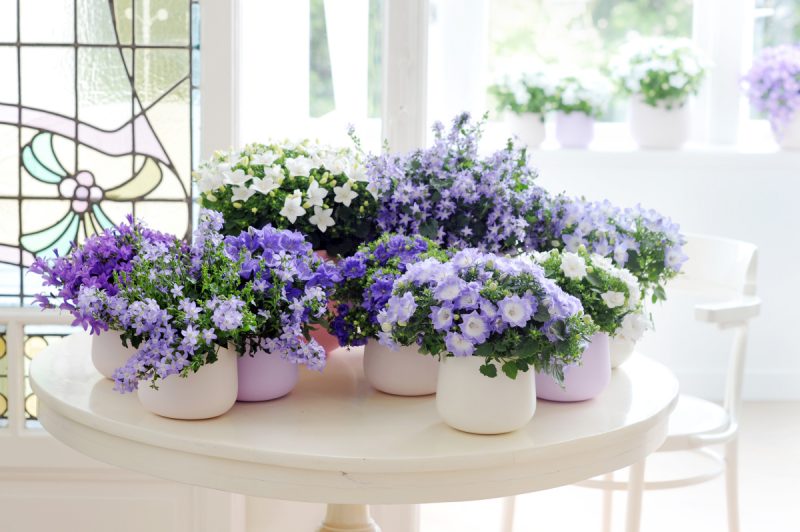
A moisture-loving plant requires regular and plentiful watering, in which the earthen lump will remain slightly moistened. With the advent of winter, the frequency of moisture is reduced to 1 - 2 times a month, which will not allow the soil to dry completely.For water procedures, it is recommended to use settled water at room temperature.
Additional nutrition of the bell is organized only during a period of intensive growth, when a rapidly developing root system depletes the substrate with high speed. Mineral complexes for flowering plants are used as fertilizer for top dressing.
The frequency of application of nutrients is 2 to 3 times per month.
Trimming and shaping a bush
When the stagnation stage occurs, which occurs in the middle of autumn - the beginning of winter, the bell shoots are shortened to 10 - 12 cm. With the arrival of spring, thin stems are again shortened to 5 cm. The procedure is performed to stimulate branching, since there are many dormant growth points at the base of the shoots of the campanula .
What to do if the plant does not bloom?
Campanula home has a beautiful flowering.
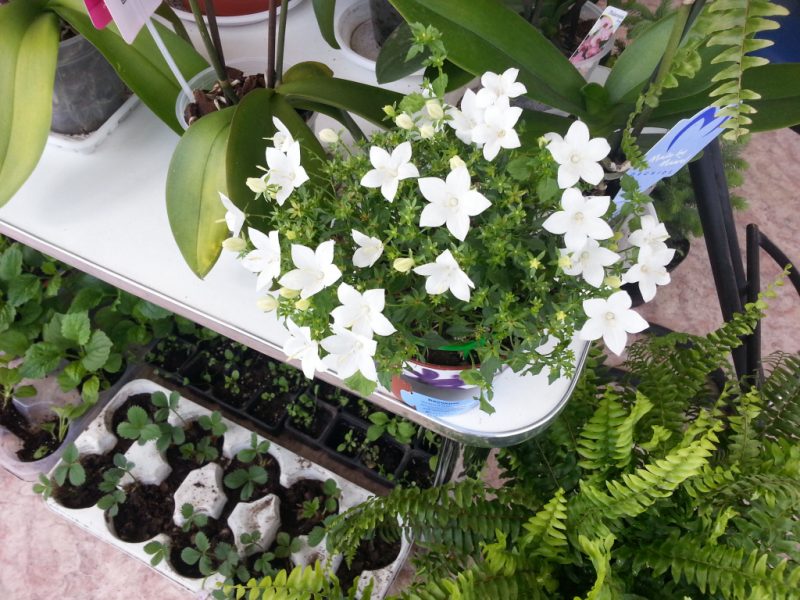
However, there are reasons why there are no flowers or there are too few of them:
- Age. The plant is too old and in the spring should be cuttings for young specimens.
- Lack of lighting. With a small number of flowers, it is necessary to correct the lighting mode by moving the pot on a sunny windowsill without access to direct rays.
- Depletion of the substrate. For lush flowering, the plant needs a lot of nutrients, which the campanula can get by regular fertilizing with phosphorus-potassium fertilizers.
The consequences of improper care and solutions
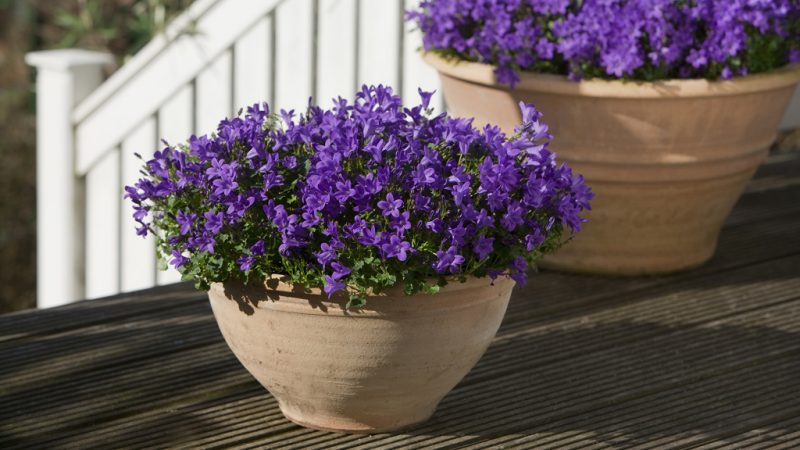
In case of violation of the care regulations, the following difficulties may arise:
- Yellowing leaves. A problem situation occurs when there is an excess or lack of soil moisture.
- Blackening shoots. Excessive watering can cause soil mold and fungus development, in which case the specimen should be immediately transplanted into a fresh substrate.
- Discoloration of flowers and wilting of foliage. The reason lies in direct sunlight, from which the bell should be protected by placing the pot on the east or west windowsill.
Pest and Disease Control
With the development of fungal diseases, which are noted in violation of the irrigation regimen, the campanula is treated with fungicide. In case of damage to the root system in a diseased plant, diseased roots are removed, after which the flower is planted in a new soil mixture and treated with a fungicidal preparation.
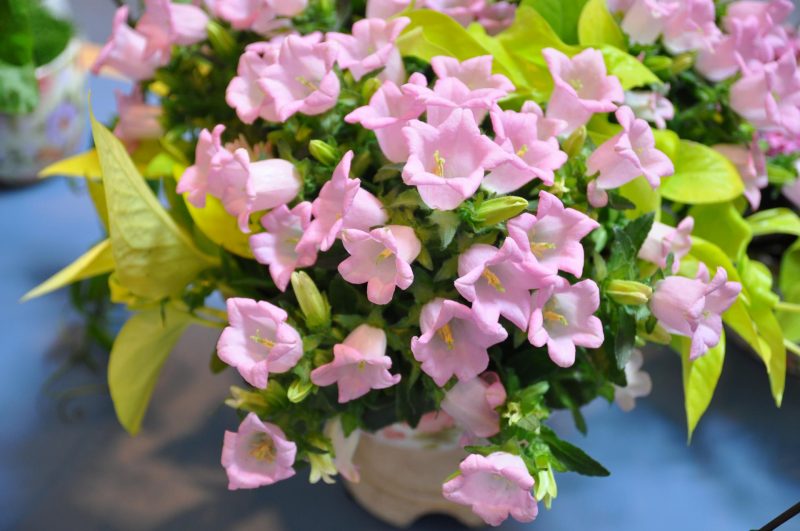
If the air is too dry, the campanula is damaged by sucking pests - a spider mite and a scab. If dangerous insects are identified, the flower should be sprayed with an insecticide. In case of strong occupation, the treatment should be repeated after 10 days.
Campanula bell propagation
The bell can be propagated not only by the seed method, which is described above, but also by more reliable vegetative methods - dividing the bush and cuttings.
Cuttings
The procedure is performed in autumn and spring, while there is a certain difference.
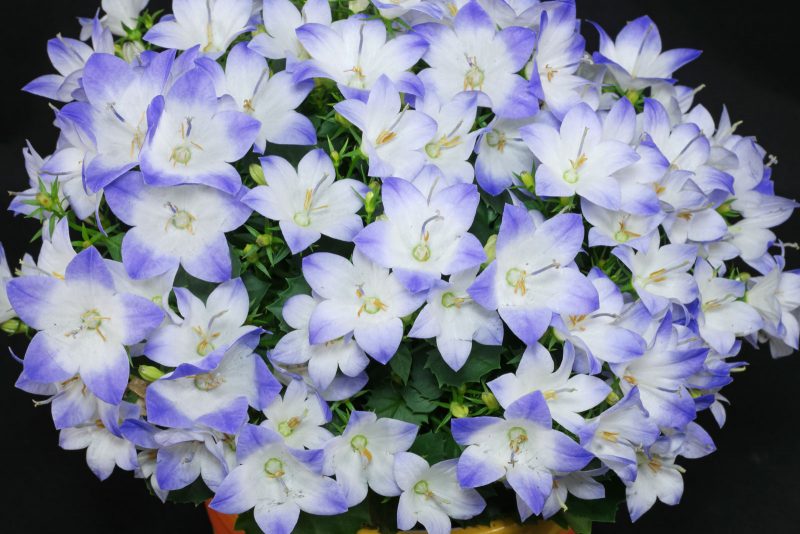
When autumn grafting:
- Cuttings 10 cm long are prepared from the shoots remaining after the autumn pruning.
- Planting material is buried in a substrate of peat and sand and covered with plastic bottles.
- Rooting is carried out at a temperature of 20 - 25 ° C with periodic spraying of plantings.
- After new plants reach a height of 10 cm, they are pinched for greater bushiness.
In case of spring cuttings:
- Cuttings of a similar length, but with a heel, are prepared after the start of shoot growth during spring pruning.
- Rooting is carried out in the same substrate under the hood, but at a temperature of 12 ° C.
- After the appearance of new leaves, specimens are planted in individual pots, which are placed in a warm, bright place.
Bush division
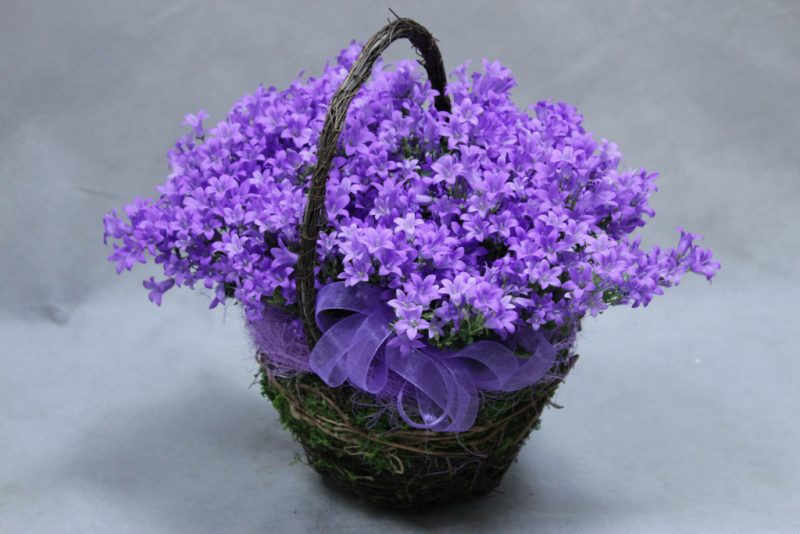
If the grower is the owner of an adult bush, then young plants can be obtained by dividing:
- The rhizome is divided into several parts with a sharp tool.
- Places of cuts are processed by crushed charcoal.
- Delenki are seated in individual pots filled with loose substrate.
- After planting, new plants are watered and transferred to a bright place, protected from too bright rays.
So, beautiful and delicate flowers can be grown not only in open ground. With a little effort, the florist will decorate the interior of his home with bright colors of many miniature bells.












